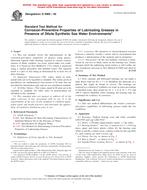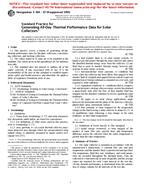1.1 This test method covers the calibration of ultraviolet light-measuring radiometers possessing either narrow- or broad-band spectral response distributions using either a scanning or a linear-diode-array spectroradiometer as the primary reference instrument. For transfer of calibration from radiometers calibrated by this test method to other instruments, Test Method E824 should be used.
Note 1-Special precautions must be taken when a diode-array spectroradiometer is employed in the calibration of filter radiometers having spectral response distributions below 320-nm wavelength. Such precautions are described in detail in subsequent sections of this test method.
1.2 This test method is limited to calibrations of radiometers against light sources that the radiometers will be used to measure during field use.
Note 2-For example, an ultraviolet radiometer calibrated against natural sunlight cannot be employed to measure the total ultraviolet irradiance of a fluorescent ultraviolet lamp.
1.3 Calibrations performed using this test method may be against natural sunlight, Xenon-arc burners, metal halide burners, tungsten and tungsten-halogen lamps, fluorescent lamps, etc.
1.4 Radiometers that may be calibrated by this test method include narrow-, broad-, and wide-band ultraviolet radiometers, and narrow-, broad, and wide-band visible-region-only radiometers, or radiometers having wavelength response distributions that fall into both the ultraviolet and visible regions.
Note 3-For purposes of this test method, narrow-band radiometers are those with [delta][lambda] [∧lt;=] 20 nm, broad-band radiometers are those with 20 nm [∧lt;=] [delta][lambda] [∧lt;=] 70 nm, and wide-band radiometers are those with [delta][lambda] [>=] 70 nm. Note 4-For purposes of this test method, the ultraviolet region is defined as the region from 285 to 400-nm wavelength, and the visible region is defined as the region from 400 to 750-nm wavelength. The ultraviolet region is further defined as being either UV-A with radiation of wavelengths from 315 to 400 nm, or UV-B with radiation from 285 to 315-nm wavelength.
1.5 This standard does not purport to address all of the safety concerns, if any, associated with its use. It is the responsibility of the user of this standard to establish appropriate safety and health practices and determine the applicability of regulatory limitations prior to use.
Product Details
- Published:
- 01/01/1995
- Number of Pages:
- 5
- File Size:
- 1 file , 68 KB


